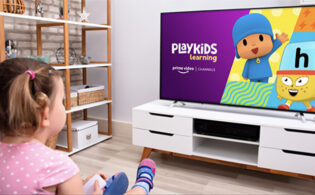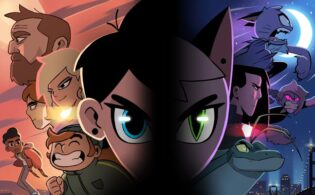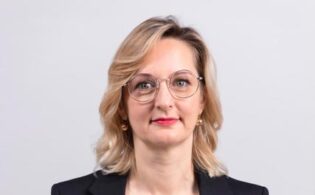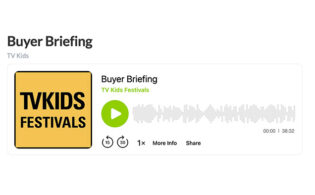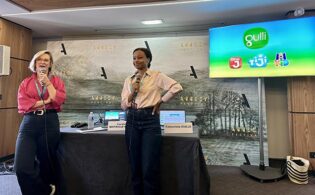The fourth edition of the TV Kids Summer Festival kicked off with our signature session on programming needs with KiKA’s Sebastian Debertin, M6 Group’s Coralie Boitrelle-Laigle, RTÉ’s Suzanne Kelly and Sandbox Group’s Ellen Solberg.
The session featured Debertin, KiKA’s head of international content acquisitions, programming and management department; Boitrelle-Laigle, M6’s director of youth programs in France; Kelly, head of children’s and young people’s content at RTÉ; and Solberg, director of content at Sandbox Group, in conversation with TV Kids’ Kristin Brzoznowski. You can watch it in its entirety here.
Last year, KiKA had 1,221 international programs across its grid, Debertin said, reflecting the crucial role of acquisitions and co-pros for the ZDF and ARD joint venture. Acquisitions and prebuys also form a key part of M6’s kids’ grid, including on the free DTT service Gulli, the pay-TV channels Canal J and TiJi and the AVOD service M6+. RTÉ commissions a slate of content to meet the needs of its audiences but is always on the lookout for acquisitions, Kelly said. Sandbox acquires for SVOD, AVOD and its FAST channel across 12 languages, with about 90 percent of its total slate made up of acquisitions, Solberg said, with an eye to buying 15 to 20 new shows over the next year for SVOD.
Asked how their acquisitions remits have shifted, Kelly noted, “An absolute prerequisite is strong box-set rights for our VOD player. We used to operate on the basis that we would sometimes get a 30-day catch-up, but that just doesn’t suffice anymore. Children are moving away from linear content. Everything is on-demand. So, we’re asking for very, very strong rights. If we can’t get those rights, we’re not buying that particular type of content. We’re also trying to build our brand very significantly on YouTube. So, we also argue quite strongly for geo-blocked and YouTube content so we can create some kind of experience on that platform, with a view to pushing toward our player.”
Debertin has been exploring new markets for acquisitions and co-pros. At Sandbox, the biggest shift has been expanding beyond preschool, acquiring content for kids aged 6 to 12. Gaming is also increasingly important, as is having a presence in FAST.
Kelly is looking at a wider array of touchpoints as well. “There’s so much content coming in from the U.S. and the U.K., it’s very, very difficult to get kids to come to a public-service broadcaster. We’re not very cool! We are always looking at the various touchpoints we can create using the content in a clever way to try to engage them back to our service.”
The conversation then moved to wish lists. Solberg stressed that everything Sandbox acquires for its various services needs to fit its key brand tenets. “We are playful. We want learning to be fun. We want the content to inspire kids to discover new hobbies and to go out and do things outside of the app and TV as well.” She is buying for multiple demos (preschool, bridge and tween), mainly series. “Long-form and short-form do different jobs across the platform. For example, on mobile, we’re seeing short-form is engaged with more. On Amazon channels and Apple channels, the longer form does better. FAST is still quite new to us. It’ll be really interesting to see how that compares to the other platforms. Our FAST channel is planned around a child’s routine. In the morning, you want getting-ready content, and then there are activities throughout the day and then calmer content at night. We do need volume. We need longer form content there that fits into those themes.”
It’s a similarly diverse set of needs at M6, Boitrelle-Laigle said. Gulli, geared to kids and families, is always in the need for comedy that reflects the brand’s values, she said. “Comedy grounded in the daily lives of children, so they can recognize themselves in the show, along the lines of hits like The Loud House and SpongeBob SquarePants. TiJi, the preschool service, has a slight girl skew and has fared well with Barbie-themed content and Zoom the White Dolphin. Canal J is in need of action-adventure fare for kids 8 to 12, with volume being a key factor “because we program in big blocks.” Volume is also key for Gulli, given its wide audience target.
RTÉ is currently well-served on the preschool front. “We’re looking for a lot of comedy and slapstick in that bridge space,” Kelly explained. “And then, as we skew older, drama. The U.K. is producing quite a lot of drama, but for a point of difference, we’re looking outside of the U.K. We buy a lot of content from Canada and Australia. Sometimes, dubbing content that’s in a different language when it comes to Ireland can be quite a difficult sell for audiences. For older kids, the 10-to-12 segment, we look for more reality-based shows. Key to what we look for as much as possible are child-centric shows that are driven by kids.”
KiKA is serving the needs of its flagship channel as well as its on-demand player. On the preschool front, “We’re cherry-picking,” Debertin said. “We’re looking at everything because you never know.” KiKA is boarding a new preschool show from Croatia, Debertin said, reflecting the wide net he has cast to fill the service’s needs. “It’s great to find these new, fresh, talented people in countries that you don’t have on your radar.”
Brzoznowski then asked the buyers about their views on content from the creator economy that is resonating with young ones.
“We have to know what this audience likes apart from our TV programs,” Boitrelle-Laigle said. “We always keep an eye on YouTube and on social media. We sometimes collaborate with YouTubers, but more [so] to promote the shows. YouTubers and influencers are local celebrities, and we need an international celebrity to build an IP. It’s really hard for us to have special content based on a YouTuber. In our shows, we make the character use the codes of YouTube and social media to create a close link between our audience and those YouTubers and this new, fresh tone that we like.”
Some of RTÉ’s shows have been fronted by local talent with significant social media followings. “Sometimes they transfer across really nicely, sometimes they don’t,” Kelly said. “The kids often sniff it out. They’re suspicious if we take their beloved social media stars and plunk them on a linear show. We’ve also tried to collaborate in interesting ways. We did a show last year called Ireland’s Future is MINE, a skill-based show with Microsoft. We’re trying to muddy the waters and not be too platform-specific. Sometimes it works, sometimes it doesn’t.”
Solberg said Sandbox is looking at the creator economy space. “I’m curious about it. Because it is user-generated content, you need a level of involvement in selecting the content and the curation.”
Kelly agreed, noting, “That can be a tricky space to navigate. You want the influencers because they’re so popular on social. You bring them onto your beloved, family-friendly, safe platform and the next thing they’re doing on social is completely at odds with your brand. It’s a tricky state to navigate, but exciting.”
KiKA has started working with social media influencers who are popular among kids, Debertin added. Viewers “see that we take them seriously and that we are where they are and also recognize that they have these new stars.”
“It also opens up loads of opportunities for the public-service broadcaster to not be so serious,” Kelly added. “It’s brilliant that we can use our platform to showcase completely demented stuff that you would only see on social media.”
On what’s missing from the market now, Kelly said she wants to see more puppet-based content. “We don’t really get offered that much.”
Boitrelle-Laigle highlighted a need for “more episodic formula shows. It’s really relevant for children to find the same beginning, middle and end, and in the middle of all three points, so many things can happen.”
Sandbox is taking more of a 360 approach to brands, Solberg said. “We have videos and games as part of our SVOD service, but we also have a publisher and activity boxes that we send out. It’s opening a whole new world for exploring brands and content and doing more with them. This is something we’re discussing now and looking at how to start testing that out.”
Debertin added, “The world for kids nowadays is so much more difficult and challenging. I’d love to see solutions. We take the kids seriously, and we want to give them a helping hand. It is not about giving kids a written manual, not a handbook, but some kind of smaller or bigger solutions for their daily lives and their future.”
The session wrapped with a conversation about exclusivity. “We’re pretty happy with things like simultaneous broadcasts,” Kelly said. “We’re really happy to geo-block for our territory. We’re not really that demanding. If we can just have strong box-set rights for our player, which is really where we’re pushing kids, the ability to exploit a little bit on YouTube to get a good taster as to what our content offering is, we’re really, really open to negotiation. That kind of protectionist outlook on content is slightly old hat at this stage. You can deliver to your territory and to your audience without demanding that you own everything.”
Debertin agreed with Kelly’s assessment but noted, “At a certain point, we need exclusivity and shows that set us apart from the others. Rights are very often a project-by-project decision. We are starting to produce a third season of The Smurfs. We wouldn’t have become one of the three lead co-producers if we wouldn’t have gotten exclusivity. For free TV and BVOD, you have to have that. If you find The Smurfs everywhere, that’s a problem.”
Boitrelle-Laigle agreed with Debertin’s perspective on exclusivity. “We are taking exclusive rights where it’s possible and wherever we can,” she said. “But it always depends on the IP, and we’re open to discussing things case by case.”
Exclusivity has not been a concern at Sandbox, Solberg said. “We’ve never really focused on buying content exclusively. We haven’t had the budget to consider it seriously because we’re covering so many territories and languages. It wouldn’t work. We’ve come in a bit later, or we’ve taken all the seasons. But I have noticed that there is a bit more availability now than there was a few years ago.”
 TVKIDS
TVKIDS
